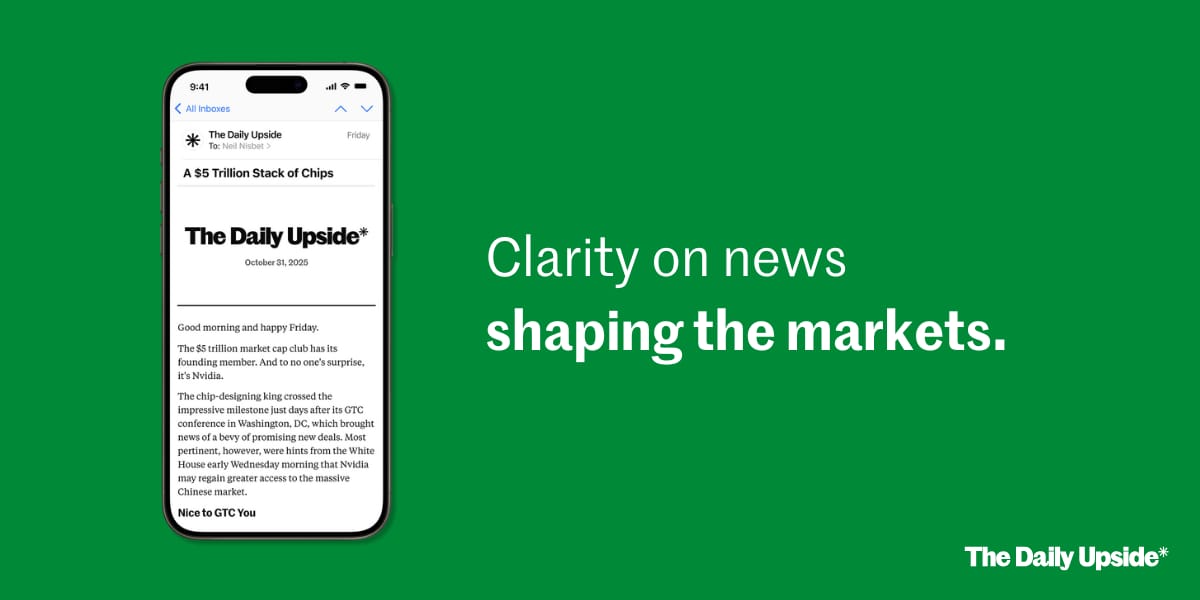Stop Drowning in Market News. Focus On Making Money.
Every day: 847 financial headlines, 2,300 Reddit stock mentions, 156 Twitter trading threads, 12 IPO updates, 94 crypto developments.
Your problem isn't lack of information; you have too much.
While you're scanning headlines wondering what matters, profitable trades slip by. The signal gets buried in noise.
What if someone did the heavy lifting for you?
Stocks & Income reads everything:
Twitter traders
Reddit buzz
IPO announcements
Crypto insider takes
Crowdfunding opportunities
Market news
Then we send you only what can actually move your portfolio.
No fluff. No useless news. Just actionable stock insights in 5 minutes.
We track every source so you don't have to. You get the 3-5 opportunities worth your time, delivered daily.
Stop wasting time on useless “investing news” and start thinking critically about real opportunities in the stock market.
Stocks & Income is for informational purposes only and is not intended to be used as investment advice. Do your own research.
🚀 Your Investing Journey Just Got Better: Premium Subscriptions Are Here! 🚀
It’s been 4 months since we launched our premium subscription plans at GuruFinance Insights, and the results have been phenomenal! Now, we’re making it even better for you to take your investing game to the next level. Whether you’re just starting out or you’re a seasoned trader, our updated plans are designed to give you the tools, insights, and support you need to succeed.
Here’s what you’ll get as a premium member:
Exclusive Trading Strategies: Unlock proven methods to maximize your returns.
In-Depth Research Analysis: Stay ahead with insights from the latest market trends.
Ad-Free Experience: Focus on what matters most—your investments.
Monthly AMA Sessions: Get your questions answered by top industry experts.
Coding Tutorials: Learn how to automate your trading strategies like a pro.
Masterclasses & One-on-One Consultations: Elevate your skills with personalized guidance.
Our three tailored plans—Starter Investor, Pro Trader, and Elite Investor—are designed to fit your unique needs and goals. Whether you’re looking for foundational tools or advanced strategies, we’ve got you covered.
Don’t wait any longer to transform your investment strategy. The last 4 months have shown just how powerful these tools can be—now it’s your turn to experience the difference.

Photo by Kelly Sikkema on Unsplash
Trading had an allure I couldn’t ignore. The idea of mastering price movements, anticipating patterns, and outsmarting the market felt like the ultimate intellectual pursuit.
At first, I believed with enough time, research, and discipline, I could extract a steady return. I told myself it was just a matter of learning, optimizing, and staying consistent.
I tested over 47 different trading strategies over two years, some of which I’ve written about. Some were popular on YouTube with hundreds of thousands of views. Others came from books, forums, paid communities, or algorithmic concepts I coded myself.
I wanted to give each a fair shot, test them across different timeframes, instruments, and market conditions. I journaled every trade. I tracked win rates, drawdowns, profit factors, expectancy, and Sharpe ratios.
And still, I came to one sobering conclusion: trading is much closer to gambling than I ever wanted to admit.
Wall Street’s Morning Edge.
Investing isn’t about chasing headlines — it’s about clarity. In a world of hype and hot takes, The Daily Upside delivers real value: sharp, trustworthy insights on markets, business, and the economy, written by former bankers and seasoned financial journalists.
That’s why over 1 million investors — from Wall Street pros to Main Street portfolio managers — start their day with The Daily Upside.
Invest better. Read The Daily Upside.
The Myth of the Perfect Strategy
The deeper I got into the mechanics of trading, the more I realized how seductive the idea of the “winning edge” can be.
Many strategies looked promising at first. From moving average crossover to momentum systems, mean reversion, RSI divergences, you name it, I’ve tested it.
Some strategies worked well in backtests. A few even held up for a while in live trading. But they all eventually fell apart. Either the market changed, slippage killed performance, or the psychology of execution became too erratic to maintain consistently.
I’d be up three months, and one choppy week would wipe it all out. I’d find myself altering parameters on the fly, hoping to fix what was never broke, or worse, chasing the next system to give me a sense of control.
That’s when it clicked for me. The market doesn’t owe anyone consistency. And most of the time, strategies stop working simply because they were never robust to begin with.
Risk Doesn’t Feel Like Risk Until It’s Real
Most traders talk about risk in abstract terms:
“Only risk 1% per trade”
“always use a stop-loss”
“have a risk-reward ratio of at least 2:1”
I followed all of that. Religiously.
But I still found myself emotionally wrecked when I’d have five or six losing trades in a row. My mind would start calculating how long it would take to recover. I’d feel the urge to tweak something, enter earlier, move the stop tighter, or exit quicker.
No backtest or simulator prepares you for the emotional weight of uncertainty. You can have the math on your side and still doubt every decision you make. And when your money is on the line, your actual money, it doesn’t feel like math anymore.
It feels like rolling dice and hoping the odds are in your favor this time. You lose faith in probabilities the moment they go against you for too long.
Most Traders Are Playing a Game They Don’t Understand
There’s a dangerous confidence that builds when you learn just enough technical jargon to sound competent. I had it. I knew how to analyze charts, understand candle formations, read order books, and automate trades.
But knowing how to do something doesn’t mean you understand why it works, or even if it does. The trading education industry is flooded with surface-level explanations and cherry-picked examples. It rewards those who can make strategies sound simple and repeatable.
But markets are messy. Price doesn’t move cleanly. News disrupts patterns. Institutions can run stops. Correlations break down. Liquidity vanishes when you need it most. And you don’t know any of that until you’ve been punished by it.
Eventually, I realized that most people selling trading strategies are just better at marketing than they are at trading. They aren’t accountable for your losses. You are!
When My Best System Still Failed
There was one strategy that felt different. It was simple, rules-based, optimized and produced an impressive equity curve during backtesting. It passed walk-forward testing and even survived some of the more volatile market conditions.
For five months, it performed well on live data. Nothing spectacular, but enough to make me believe I’d finally cracked it.
Then came a brutal 12-trade losing streak. The kind that makes you question everything. And it wasn’t due to slippage or human error. The system just stopped working. The market conditions shifted in a subtle but lethal was, sideways action with fake breakouts and inconsistent volume.
All my “edge” evaporated overnight.
That was the breaking point. If something so rigorously tested, so carefully built, could still implode without warning, then maybe the whole pursuit was flawed. Or at the very least, oversold.
What Trading Really Offers
What I took away from those 47 strategies wasn’t a winning system. It was clarity. I learned that the true skill in trading isn’t about prediction. It’s about survival. Capital preservation. Knowing when not to trade. And those are the traits gamblers rarely focus on.
Most traders are undercapitalized and overconfident. They want to double their account in six months instead of making 6% a year with discipline. They’re hooked on volatility, thinking activity means productivity.
Trading does offer something valuable, but it’s not what most think. It teaches you about uncertainty, ego, and how little control you really have. It reveals your relationship with risk and loss. And if you’re honest with yourself, it humbles you.
I’m Not Saying Don’t Trade
I still trade occasionally, but never with the same intensity or expectation. It’s a small portion of my portfolio now, more of a curiosity than a serious pursuit. I no longer feel the need to find the holy grail setup.
Some people might find a way to make it work. Maybe they have access to institutional data, superior execution, or a temperament built for sitting through pain. But I’ve accepted that I’m not one of them. And I’m okay with that.
What I’m not okay with is pretending trading is something it’s not. It’s not a guaranteed path to financial freedom. It’s not a reliable income stream for most. And it’s certainly not a skill you master just because you read a few books or build a few bots.
It’s a gamble with rules, patterns, and probabilities, but still a gamble.
Where I’ve Shifted My Focus
Since stepping back from the constant backtesting loop, I’ve shifted my attention to building longer-term assets. Things that compound. Projects that I control. Strategies that don’t fall apart because of one unexpected headline or a whipsaw candle.
Trading taught me a lot about what not to do with money. And for that, I’m grateful. But it’s no longer the pursuit I want to center my financial future around.
I had to lose a few thousand dollars, spend countless nights tweaking variables, and test 47 strategies to finally admit it: trading isn’t for me. And if you’re still deep in it, ask yourself this:
Would you keep trading if you knew it wasn’t going to pay you? Or are you chasing the thrill, calling it a plan?
Sometimes, the most valuable insight you can get from a system isn’t a profit. It’s permission to walk away.





